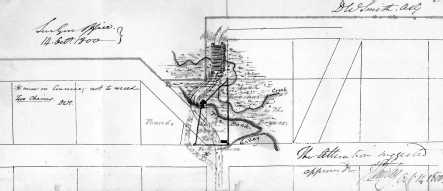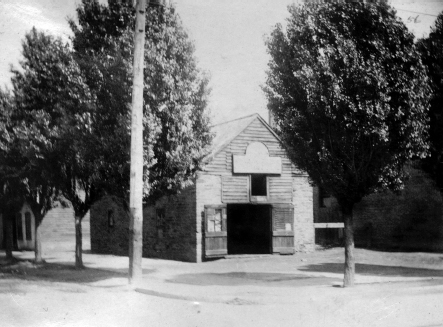
Chapter 1
TORONTO’S FIRST BREWERIES, 1800–1853
One question that surrounds brewing in early Toronto is who was responsible for brewing the first beer in the city. One possibility that is brought up periodically is that the soldiery would have been brewing for its own purposes long in advance of a commercially established brewery.
Prior to British settlement of York, there was a minor French outpost called Fort Rouillé, which occupied a position on the lakeshore on what has become the grounds of the Canadian National Exhibition. Fort Rouillé was more trading post than significant military presence. It existed from 1750 to 1759, and the outline of the wooden palisade is visible to this day. It is a natural supposition that such an outpost would have brewed its own spruce beer, although there is no record of that production.
The record that exists suggests that Abbé Picquet, while passing through the territory in 1752, “found good bread and good wine” and that the fort was better equipped than others in the region. Given the small complement of men stationed at Fort Rouillé (eight, doubling to sixteen in wartime), it is likely that they were supplied with wine and brandy from Fort Frontenac at the end of Lake Ontario. They would have had no need to produce their own beer, although they did have the wherewithal to do so.
Fort York, farther along the shoreline to the east, also seems at first glance as though it could have been a candidate for the first brewery in Toronto. Although Fort York was established in 1793, the garrison itself was quite small up until 1800 because tensions that had led to the relocation of the capital had relaxed. The vaults and wine cellar are still on display, but there is little evidence for brewing beer in the quantity needed to fulfill the rations. In the earliest days of Fort York, it is likely that beer was shipped in from Kingston or that the ration was replaced with rum.

This sketch of an irregular lot being sought for the Henderson brewery at York dates to 1800 and suggests that the brewery would have been up and running the following year (although conservative estimates date it to 1802). Toronto Public Library.
The earliest records of a commercial brewery in Toronto begin at the planning stage and display the nature of the town of York as a construct. Reverend John Stuart wrote in 1801, “The town is a Hot Bed, where every thing is forced, unnaturally, by English money. I know of no Trade now existing, or to be expected at any future Period, to support or enrich it.” Stuart clearly considered York a byproduct of the presence of the fort.
As an example, he provided a “recent fact…[a] Brewer from Kingston removed to York lately and, on application to the Governor, obtained one of the King’s vessels to transport wheat and other Grain from Kingston and the Bay of Quinte, before beer could be made.” The brewer whose tribulation he related was Robert Henderson.
The earliest record of Robert Henderson’s brewery is from 1800, and it is a planning request drafted by Sir David William Smith, one of the most trusted of John Graves Simcoe’s subordinate officers. The layout of the streets was not complete at this point, and an irregular lot at the northeast corner of Sherbourne and Richmond abutted the land that Henderson had purchased. Making up about half an acre, it was useful for the additional access it provided to Taddle Creek.
Henderson’s operation was not large. Taddle Creek powered a milling plant, but the brewing water came from wells. He was able to produce thirty barrels per week, which we know from an advertisement in the Upper Canada Gazette from 1809. With an operation of that size, he would have been brewing from late October to May, depending on the weather each year. A conservative estimate for his annual output would be 1,500 hectoliters per year.
There is some confusion in the historical record as to the date of the foundation of the second brewery, but the location is certain: it was directly across the street. George and Joseph Shaw may have opened their brewery as early as 1807 at the southeast corner of Sherbourne and Richmond.
On April 13, 1811, Robert Henderson married Elizabeth Hunter, the daughter of William Hunter, who was a blacksmith and veterinary surgeon for Governor Simcoe. Unfortunately, Robert Henderson would not live to see the first anniversary of the marriage. His untimely passing led Elizabeth to marry William Shaw, brother to George and Joseph. The brewery on the southeast corner was run by the Shaw brothers from 1812 to 1818, but it is possible that Henderson’s brewery was being run at the same time by Dr. Thomas Stoyell, a non-practicing medical doctor who had emigrated from the United States.

This blacksmith’s shop was the last surviving building related to Toronto’s first brewery. At the time the photo was taken, it was being used as a storage shed for the much larger Walz Brewery, whose chimney can be seen in the background. Toronto Public Library.
Stoyell arrived in Toronto in 1799 and for a period of six years between 1806 and 1812 ran Toronto’s first tavern, which had been erected by Abner Miles and Ely Playter. The location of Playter’s tavern at the corner of King and Sherbourne, two blocks from the locations of the breweries, guaranteed that Stoyell would have been on friendly terms with the brewers. As an expatriate American, he abandoned the tavern that he owned during the War of 1812.
By 1818, Thomas Stoyell had purchased the Shaw brewery on the southeast corner of the intersection in a partnership with John Molloy and John Doel. Little is known of Molloy, but Doel would become a brewer in his own right at the dissolution of the partnership in 1822. The same year, Stoyell married Rhoda Matthews and made the move north to Churchville, Ontario. He passed away in 1832 at the age of seventy-one, bequeathing the entirety of his estate to the Methodist Conference.
That such a donation should have come from a producer and seller of beer who had also been a Methodist steward illustrates important points about the morality of York in the early days of the century. For one thing, beer was not really viewed as an intoxicating beverage, despite all indications that it would have been above 7 percent alcohol. It was viewed as a manufactured product necessary to the function of society and compartmentalized from moral strictures except in excess. There may well have been teetotalers in York, but at the same time, the Bishop of Toronto was having barrels of ale delivered.
The Sherbourne Brewery, which occupied the southeast corner, would change hands a number of times before it met its demise by fire in 1856. The year 1833 saw John Scott operating the brewery briefly before selling it to his brother-in-law, John Lynch. Lynch operated the Sherbourne Brewery for six years before moving to Brampton to go into a new brewery partnership with Scott. Lynch became a thoroughly respected citizen, holding the office of reeve and gaining a number of awards as an essayist. In his pamphlet Canada: Its Progress and Its Prospects, he forecast the shift to large industrial brewing that would take place in the 1870s and, perhaps more importantly, illustrated a fundamental problem that would affect Toronto nearly a century and a half later. In early Toronto, the divisions in culture and in language could prove to be disenfranchising and had the effect of delaying the sense of a local character: “It is surprising how few Canadians we meet in society; you may, in this town, go into company where you will meet a large number of young people who never in their lives have been a hundred miles from Brampton, but who, on enquiry will be found to be all English, Irish or Scotch, not one Canadian.”
Cultural amalgamation may have been difficult, but Toronto was a fairly progressive place. In the 1850s, the Sherbourne Brewery’s ranks produced the first female brewer in Toronto’s history. Richard Jewell and Jane Luke Jewell had come to Canada from near St. Austell in Cornwall. Jane’s elder brother, Joseph, worked with them for a short time before founding a brewery of his own in Tillsonburg. Richard passed away in 1848, and Jane ran the brewery until 1853.